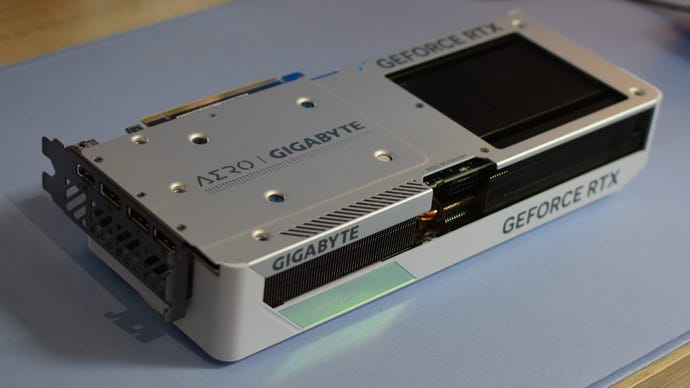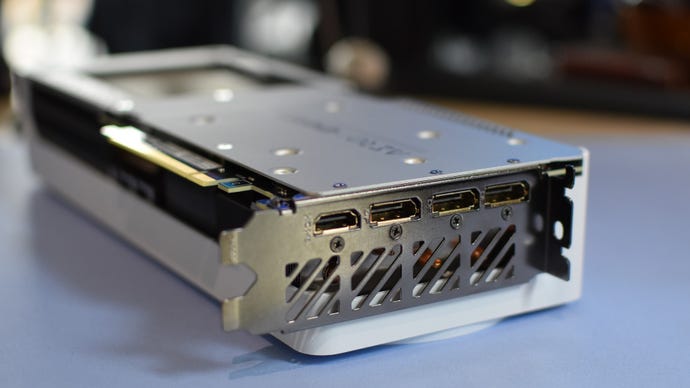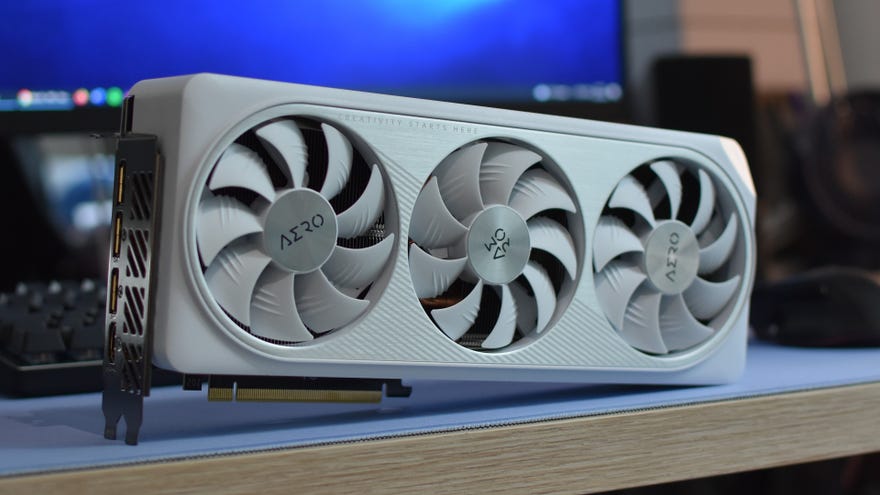Nvidia GeForce RTX 4070 Super review: what the RTX 4070 should have been
Supe’s on
It’s been two whole graphics card generations since Nvidia last tried the whole Super-branded refresh thing, and from what I recall of that sweaty 2019 summer, most of the updated RTX 20 series cards were meek rejigs of GPUs that didn’t really need replacing in the first place. Having tried the new RTX 4070 Super, though, it looks like Nvidia aren’t just redeeming the Super badge – they might just right the wrongs of the RTX 40 family as a whole.
Obviously, ultimate success will depend on the RTX 4070 Ti Super and the RTX 4080 Super as well. But all three promise higher performance, with or without DLSS and DLSS 3 sorcery, and at prices that either match or undercut their original versions. As the whole issue with the Ada Lovelace generation has been fat costs compounded by middling speed improvements over the 30 series, that all sounds good in theory, and the RTX 4070 Super shows it can deliver in practice. It even makes the RTX 4070 Ti obsolete, let alone the RTX 4070 it replaces.
GIn this specific case, I’m getting a little help from the factory overclock on the Gigabyte GeForce RTX 4070 Super Aero OC, which bumps up the boost clock from 2475MHz to 2565MHz. But even if it was running stock, boost speed isn’t actually a Super-specific improvement. Instead, it’s the base clock that gets a little nudge, up from 1920MHz to 1980Hz, while CUDA core count rises from 5888 on the RTX 4070 to 7168 here. That’s quite a chunk of extra brainpower, and the Ada Lovelace architecture remains efficient enough that max power draw only swells from 200W to 220W as a result. That’s still far less PSU slurpiness than that of the 263W Radeon RX 7800 XT, AMD’s recent-ish RTX 4070 rival.
Besides being a bit of a looker – more rounded edges please, graphics card makers – this Aero model also sports a nigh-unbelievably quiet triple fan cooler. Next to my own PC’s RTX 3090 Founders’ Edition, which whirrs like a panicked Roomba whenever it needs to render something in three dimensions, the RTX 4070 Super Aero OC keeps to a mere whisper even when firing out frames at 4K. Which, incidentally, it’s not half bad at.
Nvidia GeForce RTX 4070 Super review: 4K benchmarks
While Nvidia originally pitched the RTX 4070 as a 1440p machine, the RTX 4070 Super is basically 4K-ready from the off. Even at native rez, with zero aid from upscaling or DLSS 3’s frame generation, most games can zip along above 60fps, so you’re certainly looking at 100fps-plus in those that support DLSS or FSR. These results show how tidy a performance boost the RTX 4070 Super actually has over last year’s model: in a lot of cases, the difference between the two is roughly as big as that between the RTX 4070 and RTX 3070. Click, as always, to enlarge:
Even more enticingly, the RTX 4070 Super repeatedly catches up to – and sometimes slightly outpaces – the RTX 4070 Ti. True, that’s about to be shoved aside in favour of its own Super version, but the fact is that this GPU can go toe-to-toe with one that can easily cost £200 more. Not bad, not bad at all.

It must be said that the Radeon RX 7800 XT does well to stay on the RTX 4070 Super’s tail, even edging past in Hitman 3. Still, it’s a far more regular occurrence for the new GeForce GPU to finish ahead, and again, that’s before it can even leverage its added bonus of DLSS support. If anything, Nvidia’s upscaler seems to work even better on the Super hardware than it did before, with Quality-level upscaling able to more than double the framerates of a fully ray-traced Cyberpunk 2077. Mix in DLSS 3’s frame gen, and it even starts knocking on the RTX 4080’s door, bypassing the RTX 4070 Ti entirely:
If you are window shopping for a new 4K card, it’ll be worth waiting to see how the RTX 4070 Ti Super and RTX 4080 Super fare as well. Especially the former, which is receiving a major VRAM upgrade that should address the OG RTX 4070 Ti’s issues with certain games running max-rez textures at 4K. In terms of affordability, mind, the RTX 4070 Super is absolutely going to be the least expensive RTX 40 series option for smooth 4K, and that’s a pretty attractive notion all by itself.
Nvidia GeForce RTX 4070 Super review: 1440p benchmarks
You might even say that the RTX 4070 Super makes more sense as a ‘budget’ 4K card than it does as a devourer of 1440p. Not because it fails in this regard – again, it’s capable of major gains over the RTX 4070, especially in Shadow of the Tomb Raider and Horizon Zero Dawn. Nonetheless, its advantages narrow at this resolution, leaving the competition feeling much fiercer.
For native-rez, non-ray tracing play, the cheaper RX 7800 XT repeatedly looks like the smarter option. It matches the RTX 4070 Super’s impressive HZD peak and then some, doing the same in Forza Horizon 5, and is rarely far behind otherwise.
Once you get into more advanced settings, however, the RTX 4070 Super rises again. For one, it’s simply better than the RX 7800 XT at ray tracing, and not by particularly modest margins: Metro Exodus, running both Ultra quality and Ultra ray tracing, averaged 82fps on the RTX 4070 Super and 61fps on the RX 7800 XT. Get a gaming monitor with any refresh rate above 60Hz, and you will notice that difference. Hitman 3, with Ultra quality settings and all the ray-traced trimmings, also managed 60fps on the GeForce GPU; AMD’s card could only squeeze out 45fps.

Then there’s DLSS, which even outside of framerate concerns is a better-looking upscaler than any version of FSR thus far. But it can go faster as well, as Hitman 3 demonstrated – adding Quality-level DLSS to those RT settings allowed the RTX 4070 Super to hit 91fps, utterly thumping the 69fps that the RX 7800 XT recorded with Quality FSR 2.
The arrival of FSR 3 means that Radeon GPUs now have a frame generation alternative to DLSS 3, but AMD’s version is so lacking in game support right now that the RTX 40 series’ compatibility with DLSS 3 can still be considered a win. And with DLSS 3.5’s Ray Reconstruction available as well, albeit in just a few games itself, the RTX 4070 Super comprehensively beats the RX 7800 XT on features. As such, the fact that the two are so close on ‘core’ 1440p performance matters... maybe not little, but definitely less. You still get much, much more for your money with the Super.

Ah, the M word, a derailer (if justifiably so) of so many conversations about the 40 series’ gaming merits. I’m sure we’d all prefer it if the RTX 4070 Super was a bit cheaper, but with non-overclocked models starting from £579, you’re ultimately claiming more power for less cash than you would if you grabbed an RTX 4070 at launch. Looking at its performance, 4K included, that’s a decent deal. A tougher question would be whether to go for a customised card, like this £670 / $680 Gigabyte GeForce RTX 4070 Super Aero OC right here.
That is a hefty premium, no doubt, and much as I appreciate its willingness to be played and not heard, I suspect part of me would want to prioritise more RRP-leaning models. That said, another, more wide-eyed part might just be too enamoured with its build quality and quietness, and would likely justify itself by pointing out how this spec is still a hundred-odd quid less than the RTX 4070 Ti. Despite, remember, sometimes outperforming it. And really, how much can I argue with myself?









